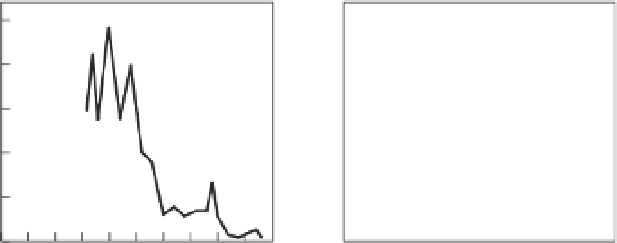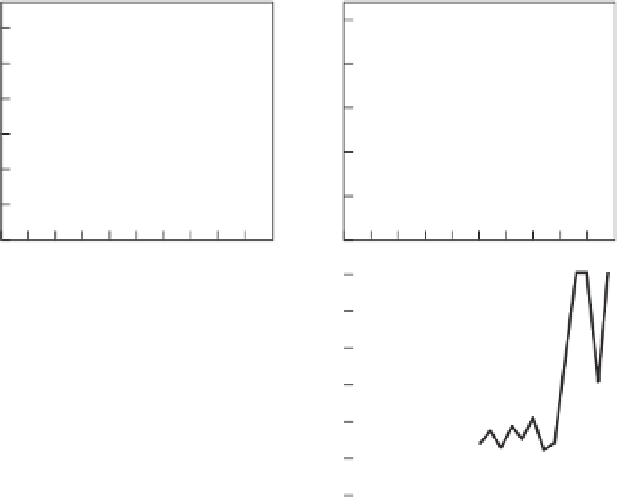Environmental Engineering Reference
In-Depth Information
(a)
0.5
(b)
3.0
2.5
0.4
2.0
0.3
1.5
0.2
1.0
0.1
0.5
0.0
0.0
1.2
250
(c)
(d)
1.0
200
0.8
150
0.6
100
0.4
50
0.2
0
0.0
1960
1970
1980
1990
2000
1960
1970
1980
1990
2000
Figure 18.5
Long-term monitoring of the effects of various P reduction measures in the shallow Dutch Lake Veluwe almost
immediately after the lake's formation. Note the marked increase in Secchi-disc transparency in the mid-1990s. The
fl uctuations in transparency, especially the decrease during 2001, are caused by wet winter periods. (Courtesy of M.L. Meijer
et al
., unpublished results.)
much longer than, and differs from, the initial route of
degradation and eutrophication. This discrepancy is
called
hysteresis
(Scheffer 1998). For example, in Lake
Veluwe (the Netherlands) macrophytes disappeared
due to ongoing eutrophication at total phosphorus (TP)
levels above 200 μ g L
− 1
, whereas the return of macro-
phytes during the lake ' s restoration or
re - oligotrophication
occurred only at a TP concentration below 100 μ g L
− 1
(Ibelings
et al
. 2007). In this case, the presence of
bottom - dwelling fi sh and their interaction with wind
promoted sediment resuspension causing high turbid-
ity of water, which reduced the light intensity and thus
prevented the return of macrophytes. Most lakes expe-
riencing ongoing re-oligotrophication approach a new
equilibrium (macrophyte presence, changes in algal
composition and decrease in their abundance) in
10-15 years (Anderson
et al
. 2005; van Donk
et al
.
2008). Some researchers (Mooij
et al
. 2005 ) expect
global climate changes will counteract the effects of
nutrient reduction in lakes and delay the recovery
process. Indeed, heavier rainfall may lead to higher
runoff of nutrients from farmland into surface waters
and higher temperatures to earlier and more release of
nutrients from the sediments into the water column.
18.3.2
In-lake techniques for P-reduction
External P-load reductions do not guarantee improve-
ments in water quality of lakes in the short term (van
Liere & Gulati 1992), primarily because of accumu-
lated P in lake sediments. In shallow lakes high stocks
of benthivorous fi sh (foraging at the bottom of the
lake), like large bream (
Abramis brama
), resuspend the
sediments and therefore contribute to P mobilization
from sediment to the water column. Apparently, this
recycled P from the sediments increases if P loading in
infl ows is reduced. Therefore, high P concentrations,
often observed in lakes during summer, and algal pho-
tosynthesis and production can go on unabated despite
external control measures. Thus, our experience is that
high levels of internal P loading may keep lakes in a
eutrophic state for years after the reduction of external
P loading.
Preventing P l oading from l ake s ediments
The cycling of P between the sediments and water is
complex and poorly understood. The P release from
sediment depends on both redox and pH and involves









